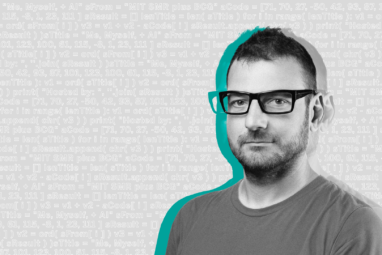Topics
Artificial Intelligence and Business Strategy
In collaboration with
BCGDaniele Petecchi didn’t realize how complex the process of producing tires was until he joined Pirelli, a company that’s been in the business of manufacturing tires for more than 150 years. But now, as head of data management and AI, he’s focused on leveraging the company’s wealth of data to meet the stringent technical, quality, and performance requirements of the Formula One racers and luxury vehicle makers — like Ferrari, Lamborghini, and BMW — that rely on Pirelli’s premium tires.
In this episode of the Me, Myself, and AI podcast, Daniele explains why virtualization and data are key to managing the complexity of an R&D and production cycle that includes using digital twins to predict how a tire will sound on the road and maximizing efficiency at plants that manufacture millions of tires each year.
Subscribe to Me, Myself, and AI on Apple Podcasts, Spotify, or Google Podcasts.
Transcript
Sam Ransbotham: When you think about digital twins and generative AI, you probably don’t think about the tires on your car, but on today’s episode, learn how firms are using AI to develop this key component.
Daniele Petecchi: I’m Daniele Petecchi from Pirelli, and you are listening to Me, Myself, and AI.
Sam Ransbotham: Welcome to Me, Myself, and AI, a podcast on artificial intelligence in business. Each episode, we introduce you to someone innovating with AI. I’m Sam Ransbotham, professor of analytics at Boston College. I’m also the AI and business strategy guest editor at MIT Sloan Management Review.
Shervin Khodabandeh: And I’m Shervin Khodabandeh, senior partner with BCG and one of the leaders of our AI business. Together, MIT SMR and BCG have been researching and publishing on AI since 2017, interviewing hundreds of practitioners and surveying thousands of companies on what it takes to build and to deploy and scale AI capabilities and really transform the way organizations operate.
Hi, everyone. Today, Sam and I are very pleased to be talking with Daniele Petecchi, head of data management and data science at Pirelli. Daniele, welcome to the show, and let’s get started.
Daniele Petecchi: Thank you.
Shervin Khodabandeh: So for those of us who are not familiar with Pirelli … I happen to have four of your wonderful tires on my car — actually, eight of them on my two cars — but for those of us who might not be familiar, can you describe the company and then your role at Pirelli?
Daniele Petecchi: For sure. Pirelli is a manufacturer focused on tires, as you said, and, in particular, tires for cars, [motorcycles], and bikes. Our target is to be on the cutting edge of R&D and the technical point in the automotive industry. Pirelli is an Italian company. It’s an old company. It’s more than 150 years old. So during that time, Pirelli changed, and now we are a leader in the prestige and premium segment, the high value. But also, we are known as the unique supplier of Formula One. If you see, on Netflix, Drive to Survive — that is the series that is related to Formula One.
Sam Ransbotham: So now I know what kind of cars Shervin drives. He’s only driving the luxury. Is this your Lamborghini?
Shervin Khodabandeh: See, I’m a high-value customer.
Daniele Petecchi: Good, good, good.
Shervin Khodabandeh: Maybe tell us a bit about your role at Pirelli.
Daniele Petecchi: Yes. I am responsible for what we call data management and AI, but in the end, I deal with [everything] that is related to data, from business intelligence reports and reporting to data engineering, data science, AI, deep learning, gen AI. We work with all the data. We work with data from our plants, we work with the data of R&D, and we work for the business with AI also, on commercial, supply chain, and so on.
Shervin Khodabandeh: Maybe give us some ideas of how data and AI are influencing all of the elements that you talked about — the whole value chain, from maybe production and R&D to maybe supply chain. Can you give us some examples?
Daniele Petecchi: Oh, yes. The business model is a simple business model, but it is for sure powerful. Our target is working with our carmaker. So this is our idea: We work with original equipment, and then we can support our replacement market. Moreover, we do this with a benefit in terms of the time frame of our business. The carmaker calls us to develop the tire for a new car three years in advance of the launch of a new car model. Then the new car model is launched. After four years, we have the first replacement wave. After four years again, we have the second wave of the replacement.
At the end, this provides us with visibility, this time frame of 11 years. So when we start with the new business, we predict the next 11 years due to the fact that we launch the new car — the carmaker launches the new car — and then we work on the replacement. So this is powerful for our business model, but it’s also challenging for the use of data because we have to work over these 11 years to guarantee the supply of the product, the quality of the product, because we are working on the prestige and the premium market and the high value — Ferrari, Lamborghini, BMW. I don’t want to say all the brands, but those are the top brands.
Based on this, let’s consider that every year, we produce more than 60 million or 70 million tires. We produce these tires in 18 plants around the world. We provide our tires to almost 60 markets around the world, and to manage this — because each year we produce 2,000-3,000 different SKUs — the tire is pretty different inside for each model, because there are the inner rims, there are the winter and summer tires, and so on.
Shervin Khodabandeh: All those speed ratings and all the letters and everything, yep.
Daniele Petecchi: You’re an expert! So you have to manage this complexity and guarantee the quality of our product for this brand that, I would say, has strong requirements in terms of technical requirements, in terms of performance requirements — to do this, we need data. The data is the only way to manage the complexity.
As I said, Pirelli 150 years ago produced tires, but it was a different scenario. The competition today is pretty different. It’s a global competition. The challenge we have to face with the market — that is for sure different, and the requirements, as I said, of our customers are really challenging too.
In terms of an example, I’ll go straight to the example where we apply the AI. As I said, the data is the building block of our business model. For example, we can start from R&D. Particularly in the past, when you develop a new tire, you start with the technical requirements, you design a new product, then you produce a prototype, test it, and then update the design of the product. So it was a kind of development based on different loops due to the fact that you have to try a different recipe for each tire.
I can tell you that the tire is like a pie, OK? You have the ingredients. You prepare your pie, and then you have to cook it.
Shervin Khodabandeh: I’ve had those kinds of pies that taste like a tire.
Sam Ransbotham: How long does that process take — that iterative process you’re describing? How long is that taking?
Daniele Petecchi: Starting from the body, 30 minutes to produce one tire.
Sam Ransbotham: How about the design process, though?
Daniele Petecchi: The design process requires — in particular for the prototyping phase — required several months in the past. And for this, artificial intelligence is able to support R&D because you can virtualize your product development with AI.
Shervin Khodabandeh: A digital twin, you’re talking about.
Daniele Petecchi: Yes, a digital twin. You have to consider that a digital twin for this kind of product is based on AI. When you want to predict, for example, the noise of a tire, there is no simple equation that says, “OK, guys, for this tire, this is the noise.” No; no. And today, the noise is really important because, as you said, with electric cars, there is no noise in the engine. The only noise of an electric car is related to the tires.
Sam Ransbotham: Right. Before, the engine would cover up those noises and you didn’t have to worry about it, but now, with new models of cars, then you’re [under] a lot more pressure.
Daniele Petecchi: Yes, there is more pressure that the tires produce noise. Moreover, there is the ESG [environmental, social, and governance] stream, so it’s important because the noise is also related to the ESG requirement. At the end, if you want to predict what would be the noise of a tire, I can tell you that it’s art with the theory.
We trained our neural network, a neural network model. And we developed this kind of model that was able to predict the noise of the tire. But we are lucky. We have the data. We have the data of the experiments of the prototypes that were tested in the past. So … we develop a huge amount of data. We develop this kind of model — a deep learning model — that is able to predict the noise of a tire based on the design of the product and other technical parameters, without the prototyping phase. So by this model, we are able to support R&D, reduce the time to market that they say is several months to develop a new product. We can reduce the time to market and then also the cost of the development of a new tire.
Shervin Khodabandeh: You have the benefit of data and the ability to experiment more than a brand-new brand.
Daniele Petecchi: Yes. And then we can base our leverage on our historical data. We trained our model, and with this model, we are able to predict not only the noise. With the AI, we also suggest the proper recipe of our tire for a new product according to the customer requirements.
Shervin Khodabandeh: So you dramatically reduce the prototyping and testing phase …
Daniele Petecchi: Yeah.
Shervin Khodabandeh: … before you go to full-scale production. And it’s sort of like what we talked [about] with Moderna, for example, on coming up with new vaccines, right? Because this whole process of trial and test and trying different variations or coming up with new formulas — this is quite fascinating. I can also imagine the manufacturing process, once you have defined the recipe and the design — that that manufacturing process of nearly 100 million tires a year with plant time and production line and all that must also be quite complex. Are there examples of AI helping you run that more efficiently, more effectively?
Daniele Petecchi: Oh, yes. In manufacturing, in the production process, the target, as I said, the R&D target is virtualization. In the production process, it’s efficiency. So we apply our model to provide more efficiency in our production plan [and], at the same time, to guarantee the quality. Because I will say that our customers are strong in terms of quality and technical requirements.
And with AI, you have to change the approach of your plans, starting from a reactive approach to a preventive approach. And this is what we put in place with predictive maintenance: predictive quality. You have to be able to predict the quality of your product before you complete the production. So it’s important that if you want to provide the efficiency in your production process, they cannot wait [until] the end of the process to say, “Oh, unfortunately, this product is not good. Waste.” No.
During your production process, you have to be able to, let’s say, provide the early warning of something that could go wrong and then react before that something happens. And this is based on artificial intelligence for us. So during the process, collecting the data with IoT [sensors] — because we collect the data from our machines — we are able to detect if something is going wrong that could impact the end quality of our product, and then we have to do something during the process.
Shervin Khodabandeh: So rather than stopping the process, you modify and adjust during the process.
Daniele Petecchi: During the process. The challenge is to do something during the process. If you stop the process …
Shervin Khodabandeh: It’s a big deal.
Daniele Petecchi: It’s a big deal. Because it’s for sure inefficient to stop the process and then start again.
Sam Ransbotham: So when I think about, for example, the complexity of what you’re doing … you know, you made the analogy to a pie, and if I think about a pie, I might have some flour and some sugar and a filling, like a pecan, or a pecan if you’re where I’m from, these fillings … you know, there’s like half a dozen different ingredients you could combine. But my guess is the complexity for these people you’re working with is much larger. What’s the number of ingredients in the pie for a tire?
Daniele Petecchi: Yeah, more than 100 ingredients. And if you consider the tire, you have 26 parts of a tire that are built and then cooked. For sure, when I moved to Pirelli — because I’d had experiences in other companies, other industries — I was surprised about the complexity of their production process. But I said, “Well, if you consider a tire, a tire is under a car. A car is more than one ton of weight. If you consider electric, it’s more than one — almost two tons of weight.”
And if you consider this, if you consider that a tire has to support a car [like] a Ferrari for 300 kilometers per hour of speed, as well as the temperature — because the weather conditions could change — so we can start in winter in Italy with a temperature that is zero degrees [Celsius] to 40 or 45 degrees in the summer.
Shervin Khodabandeh: Hmm. That’s like 130 Fahrenheit for the American audience, right? It’s pretty hot.
Daniele Petecchi: Yes. But if you consider all these, conditions, you say, “Wow. The tire — it’s not simple, the life of a tire.”
Sam Ransbotham: So, what that makes me think about is how much the potential for generative AI is. When we think about generative AI, we think about language models that people are used to here. But you’re not just predicting noise. You’ve got a whole bunch of data that will tell your workers potential combinations that might work well. That’s a very different generative world than generating sound or generating language. That generative design seems different.
Daniele Petecchi: Generative AI is something that we apply. You apply a model of generative AI, in particular related to the language, but, to be honest, I can see the AI in Pirelli split in two main streams. One is the stream that I described before, the stream of the operation, and this is something that, let’s say, is based on deep learning. It’s based also on generative AI, but generative AI not related to language.
With generative AI, we cover something that was a new opportunity, in particular for the division, for the colleagues, that work with text. But to be honest, what I described before, generative AI is not only text. Related to the suggestion of a compounding of the ingredients of a new tire is generative AI. So generative AI is, as we discussed, about the idea that our models are able to propose something that in the past was proposed only by humans.
So gen AI, as I said, today — by the hype of ChatGPT — is, in particular, applied for a sister function. But behind our predictive model — our model that virtualizes the R&D — also behind this model, there is a generative model.
Sam Ransbotham: Right. That seems particularly interesting. You mentioned before that you didn’t realize this before you came to Pirelli. Well, tell us about your life before Pirelli. What did you do? What’s your background? How did you get interested in Pirelli and then interested in tires?
Daniele Petecchi: My background is, I am an engineer. I’m an engineer in digital signal processing. And after university, I supported my professor in Italy for [research] related to the data in the telecommunications industry.
Then I started in a consulting company. Then I moved to the telecommunications industry. Then I had the opportunity to see the utility and oil and gas industry, and also retail. So I saw the opportunities with the customer base — so, the consumer — in telecommunications and in utilities. I had the opportunity to see the behavior, in terms of data, of the shop in retail, and then I said, “Oh, what is missing? Manufacturing.”
So when I had the opportunity with this challenge at Pirelli, I said yes. It’s a really good opportunity because this data strategy is inside our digital transformation in Pirelli. Here at Pirelli, we started in 2018, not only with a data strategy, a data-driven approach, a different data-driven … We started with a new digital transformation to support the business model that I described before. We started this kind of transformation that is based on data, and over data we also have a transactional process based on a CRM [customer relationship management] tool, based on a product life cycle management tool, based on a new tool that supports the production process — the IoT project.
If you consider the production process, the point is that you can see, you can touch the benefit of what we do. If you, let’s say, are able to provide better quality in the product, you see at the end of the process what are the benefits of your model, of your work with data.
Sam Ransbotham: I like the way you tied all those together too.
Shervin Khodabandeh: It’s a wonderful narrative. So we have a segment of our show; it’s called five questions, where I’m going to ask you five questions. You don’t know what they are — hopefully you don’t know what they are. Just tell us the first thing that comes to mind. Just rapid answers — quick, 10-second answers is what we’re looking for. So — ready?
Daniele Petecchi: Three, two, one … Oh, I’m a little bit stressed. OK!
Shervin Khodabandeh: What do you see as the biggest opportunity with AI right now in the world?
Daniele Petecchi: In the world. For sure I think to better support the human in day-by-day work. I think this will only provide benefits for people, that it will leave boring activities to be focused on value-added activities. This is the main benefit of AI.
Shervin Khodabandeh: What is the biggest misconception that people might have about AI?
Daniele Petecchi: That AI will substitute the human in their job.
Shervin Khodabandeh: What was the first career you wanted? What did you want to do when you grew up?
Daniele Petecchi: Work with data. In any case, with the new era of data.
Shervin Khodabandeh: As a 5-year-old you wanted to work with data?
Daniele Petecchi: [Laughs.] In any case, the data with the next gen of data.
Shervin Khodabandeh: Is there such a thing as too much AI? When is there too much AI?
Daniele Petecchi: It’s not [that there’s] too much AI. It’s about the marketing of AI. You want to do something? “Oh, this is AI.” If you want the sum of two numbers? “This is AI.” So there is an overselling. The point is the overselling of AI.
Shervin Khodabandeh: Good perspective. What is the one thing you wish AI could do that it cannot do right now?
Daniele Petecchi: I think that AI today [could] work with the industries, with the process. I think that health and safety could be better [with] the support of the AI.
Shervin Khodabandeh: Very good.
Sam Ransbotham: Daniele, we really appreciate you taking the time to talk with us. Something like tires is probably not something that we all think about a lot. They just work. And until we hear them or they start making noise, we don’t worry about them. But what you’ve done is given us an insight into how complex that process is and how the humans and the machines can work together to learn how to make better tires for us all. I think that’s really interesting. Thank you for taking the time to talk with us today. We appreciate it.
Shervin Khodabandeh: Yeah, thank you so much.
Daniele Petecchi: Thank you. Thank you for this interesting discussion.
Shervin Khodabandeh: You also got us to think about pie.
Sam Ransbotham: Are you hungry now, Shervin?
Shervin Khodabandeh: I am very hungry.
Daniele Petecchi: When you’re cooking the next pie, please …
Shervin Khodabandeh: Totally into pies. I want to drive fast and get pie.
Daniele Petecchi: Remember the tire when you prepare the next pie.
Shervin Khodabandeh: Thanks for listening. On our next episode, we learn how AI and generative AI help people collaborate more effectively, with Jackie Rocca from Slack.
Allison Ryder: Thanks for listening to Me, Myself, and AI. We believe, like you, that the conversation about AI implementation doesn’t start and stop with this podcast. That’s why we’ve created a group on LinkedIn specifically for listeners like you. It’s called AI for Leaders, and if you join us, you can chat with show creators and hosts, ask your own questions, share your insights, and gain access to valuable resources about AI implementation from MIT SMR and BCG. You can access it by visiting mitsmr.com/AIforLeaders. We’ll put that link in the show notes, and we hope to see you there.







